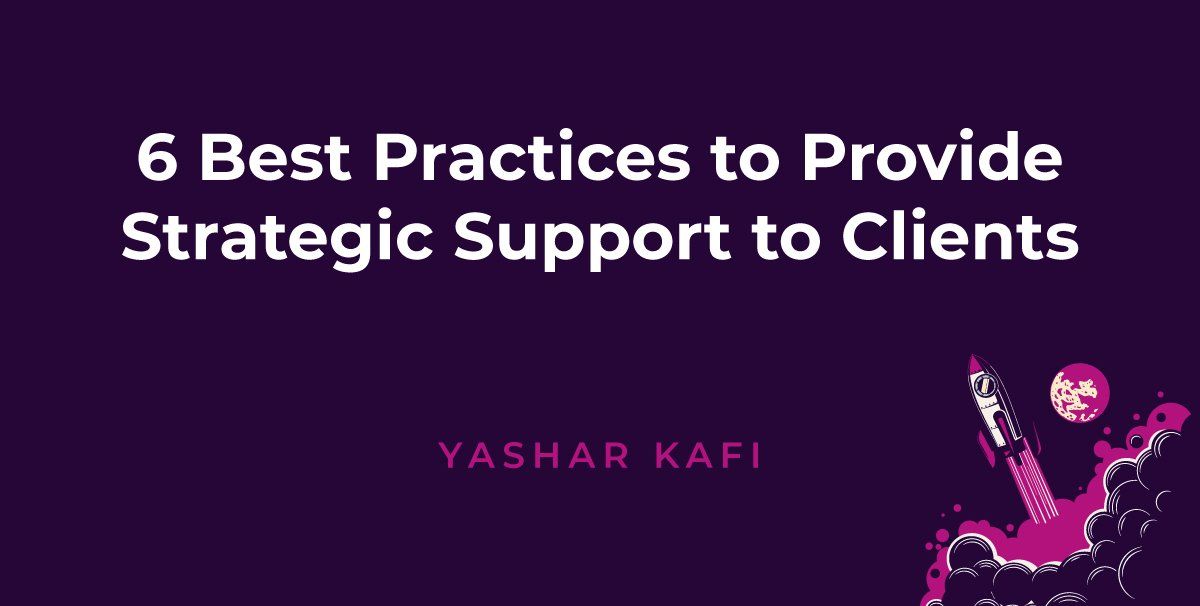6 Best Practices to Provide Strategic Support to Clients
Most professionals agree that providing excellent strategic client support is a top priority for organizations. But what’s not always agreed on is how to reach this goal.
That’s why I wanted to bring you some ideas on how to provide strategic support to clients—six best practices, to be exact. I’ll also explain why support matters.
What Is Strategic Client Support?
The goal of providing strategic client support is to produce a long-term, profitable client relationship. The strategy is to foster your relationship with your client by delivering a consistent customer experience: keeping them happy and motivated to stay with you for the long haul. It requires intentional management of their needs at every level and point of contact, strategies which we will discuss further.
Why Does Providing Client Support Matter?
So, why does this matter to the client, and why should you care about it as a company? The answer is simple: Clients want to know that you hear and appreciate them and that you are listening to—and addressing—their needs. For businesses, providing strategic client support keeps customers happy and with you long-term.
Numbers prove how much of a premium customers place on stellar client support. One study reveals that a majority of consumers (a whopping 52%) are willing to pay more if it means they will receive better service and support. So, here are six ways you can do just that.
6 Best Practices for Strategic Client Support
1. Understand Your Clients’ Needs
The first thing to understand about your client base is that each client will have unique needs, which means you’ll need to learn these needs to best serve them. For instance, if your client requires face-to-face interactions for assurance, you will need to provide that. Other clients may prefer to work through email or Slack, so they can check it when it’s most convenient.
2. Be Proactive
The Oxford English Dictionary defines proactive as “creating or controlling a situation rather than just responding to it after it has happened.” This correlates to strategic client support: thinking ahead and anticipating needs are the first things that come to mind. When you can predict a customer’s future needs and keep them in the loop, this fosters trust and satisfaction in your client base. They feel safe in your hands because you are alert and “on it” versus sitting on the sidelines waiting to react to things as they come.
3. Make Processes Easy
We are all customers of some sort. Think back to when you’ve needed customer service but ended up frustrated instead. Perhaps the customer service helpline was no help at all, or it was impossible to navigate set up for that “simple” automatic payment feature that’s intention was to make your life easier but only confused you.
No one wants to deal with headaches and frustration—life is hard enough! So, when it comes to your clients, make it as easy as possible for them to get in touch with you when they need to.
4. Offer Multiple Self-Service Options
We live in a world where automation and self-service are the norm. We want to do it ourselves and in the manner that best suits us. For this reason, offering your clients multiple self-service options will always be a win.
5. Provide Personalized Client Support
People like to feel special. We want to think that something has been designed for us. Today there is a premium on personalization. There are many ways to do this for your client, for instance, addressing emails to them by name. Another great idea is to refer to previous purchases or interactions you’ve had with them, adding another layer of personal touch and showing your clients you remember them; they are not just numbers on a credit card.
6. Ask for Feedback
To best serve a client, you must first know what they do and don’t like and what you are doing that is or isn’t working for them. Asking for customer feedback is an excellent way to gauge how you are doing with client service. After all, you can’t improve what you don’t know needs improving on
To learn more about how you can provide strategic support to clients, reach out to the AMP team today.




